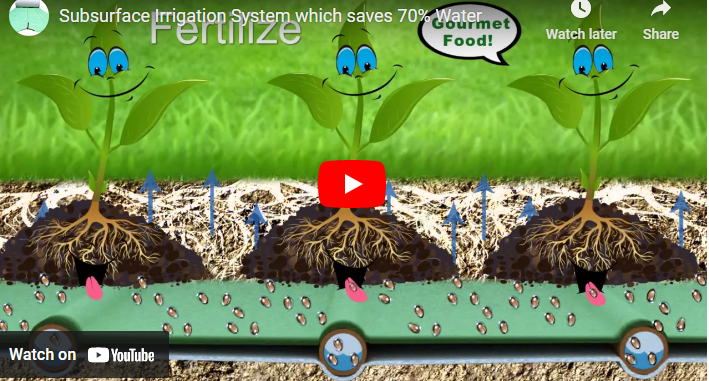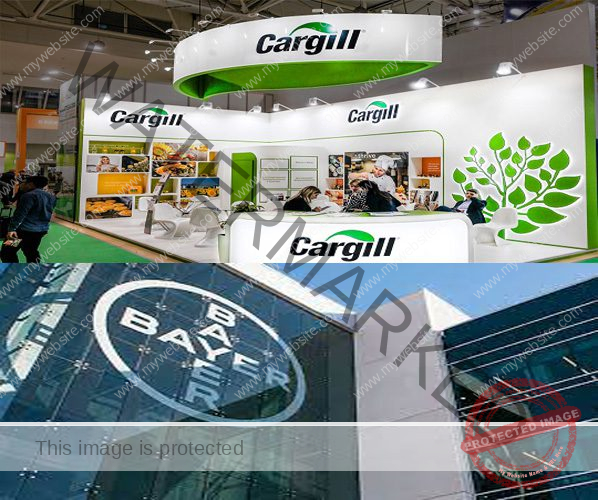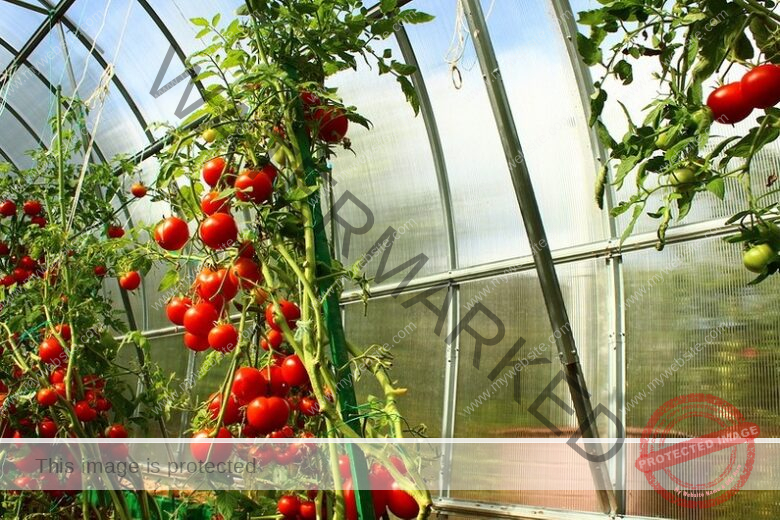In this comprehensive guide, we will delve into the depths of subsurface irrigation systems, exploring their benefits, functionality, and applications. Whether you’re a seasoned farmer or a curious enthusiast, this is your opportunity to uncover the secrets of this advanced irrigation method.
Discover how subsurface irrigation systems work silently beneath the surface, conserving water, optimizing nutrient uptake, and promoting healthier root systems. Join us as we explore all you need to know about subsurface irrigation systems in agriculture.
Subsurface Irrigation Systems Agriculture [All You Need To Know]
Subsurface irrigation, a highly efficient and water-saving technique, involves the utilization of buried drip tubes or drip tape to provide precise water delivery to crops.
By operating at low pressure, this system minimizes water loss due to evaporation and significantly reduces weed growth and disease occurrence, leading to improved yields.
With its ability to target the root zone directly, subsurface drip irrigation optimizes water usage and enhances crop health, making it an effective and sustainable irrigation method for maximizing agricultural productivity.
This irrigation technique offers several advantages over traditional surface irrigation methods. The system consists of components such as
- Water Source: The water source can be a well, pond, reservoir, or water supply system. It provides the water that will be distributed through the subsurface irrigation system.
- Pump: The pump is responsible for pressurizing the water from the source and supplying it to the irrigation system. It ensures a consistent and controlled flow of water.
- Distribution Network: The distribution network includes pipes or tubing that transport the pressurized water from the pump to the irrigation zones. These pipes are typically buried underground to deliver water to the subsurface.
- Emitters or Drippers: Emitters or drippers are small devices installed in the distribution network that release water directly into the soil. They are designed to deliver a controlled and uniform flow of water, ensuring even distribution throughout the root zone.
- Filters: Filters are crucial components that remove debris, sediments, and other impurities from the water before it reaches the emitters. They prevent clogging and ensure the smooth operation of the system.
- Control Valves: Control valves regulate the flow of water within the system. They can be manually or automatically operated and are used to turn the irrigation system on or off, control the water pressure, and manage water distribution to different zones.
- Pressure Regulators: Pressure regulators maintain a consistent and optimal pressure within the system. They ensure that the water flow remains within the desired range, preventing damage to the emitters and ensuring uniform water distribution.
- Monitoring and Control System: Advanced subsurface irrigation systems may include sensors, controllers, and automation technology. These components monitor soil moisture levels, weather conditions, and other parameters to optimize irrigation scheduling and water management.
- Root Zone: The root zone of the plants is where the water is delivered. The subsurface irrigation system ensures that water is directly supplied to the root zone, promoting efficient water uptake and reducing evaporation losses.
- Soil: The soil serves as the medium through which water is distributed and absorbed by plant roots. Proper soil preparation and management are essential for optimal water distribution and plant growth.
How to Install Subsurface Irrigation System
Installing a subsurface irrigation system requires careful planning and implementation. Here is a step-by-step guide to help you install a subsurface irrigation system:
Step 1 – Design the System
Assess your field and determine the irrigation requirements, including water flow rate, spacing between emitters, and coverage area.
Consider factors such as soil type, crop type, and topography to design an efficient system.
Step 2 – Prepare the Area
Clear the field of any obstructions, vegetation, or debris. Remove any rocks or large objects that could interfere with the installation process.
Step 3 – Dig Trenches
Dig trenches or furrows along the rows where the irrigation lines will be placed.
The depth and spacing of the trenches will depend on the crop’s root zone and system design.
Step 4 – Install Mainline Pipes
Lay the mainline pipes along the trenches, ensuring a proper slope for water flow.
Connect the pipes using appropriate fittings and secure them firmly.
Step 5 – Install Emitters
Place the subsurface emitters at regular intervals along the mainline pipes, adhering to the design specifications.
Connect the emitters to the mainline pipes using connectors or fittings.
Step 6 – Test the System
Conduct a thorough inspection of the installed components to ensure there are no leaks or damages.
Run water through the system to test the flow rate and functionality of the emitters.
Step 7 – Backfill Trenches
Carefully backfill the trenches, ensuring the mainline pipes and emitters are covered adequately. Avoid damaging the installed components while backfilling.
Step 8 – Install Filters and Pressure Regulators
Install appropriate filters and pressure regulators to maintain water quality and control the water pressure within the system.
Connect these components to the mainline pipes according to the manufacturer’s instructions.
Step 9 – Connect to Water Source
Connect the mainline pipes to the water source, which can be a well, reservoir, or water supply system. Install a pump if necessary to ensure proper water pressure and flow.
Step 10 – Test the System Again
Run water through the system to check for any leaks, malfunctions, or uneven water distribution. Adjust the flow rate, pressure, and positioning of the emitters as needed.
Step 11 – Cover the System
If required, cover the installed subsurface irrigation system with a layer of soil or mulch to protect it from damage and promote uniform water distribution.
Step 12 – Regular Maintenance
Implement a regular maintenance schedule, including periodic inspection, cleaning of filters, and repair or replacement of any faulty components.
Monitor the system’s performance and make adjustments as necessary to ensure optimal water distribution and plant health.
Types of Subsurface Irrigation System
- Subsurface Drip Irrigation (SDI): In SDI, water is delivered directly to the root zone through buried drip lines. This system ensures precise water application, minimizing water loss and optimizing water uptake by plants.
- Subsurface Textile Irrigation (STI): STI involves the use of geotextile fabrics with integrated emitters placed below the soil surface. Water is evenly distributed through the fabric, providing uniform moisture to the root zone.
- Buried Clay Pot Irrigation: This traditional method involves burying porous clay pots filled with water in the soil. The water slowly seeps out of the pots, irrigating the surrounding plants.
Benefits of Subsurface Irrigation System
- Water Efficiency: Subsurface irrigation systems minimize water loss due to evaporation, wind drift, and runoff. Water is directly delivered to the root zone, ensuring efficient utilization by the plants.
- Improved Plant Health: Precise water application near the roots promotes healthier plants with reduced foliar diseases and weed growth. It facilitates better nutrient uptake and root development.
- Weed Control: Subsurface irrigation reduces weed growth as water is targeted to the plant root zone, minimizing moisture availability for weed germination and growth.
- Reduced Labor and Energy Costs: Once installed, subsurface irrigation systems require less maintenance and labor compared to surface irrigation methods. They also consume less energy, especially in pressurized systems.
- Versatility: Subsurface irrigation can be used in a variety of soil types, terrains, and crop varieties. It can be customized to fit different field shapes and sizes.
Limitations of Subsurface Irrigation System
- Initial Cost: The installation cost of subsurface irrigation systems can be higher compared to traditional surface irrigation methods. This includes material cost, equipment cost, and labor.
- System Design Complexity: Proper design and layout of subsurface irrigation systems require expertise and knowledge of soil conditions, crop water requirements, and hydraulic principles. Inadequate design can lead to uneven water distribution or system inefficiencies.
- Maintenance Challenges: While subsurface irrigation systems require less day-to-day maintenance, occasional inspection and cleaning of emitters, filters, and components are necessary to ensure optimal performance.
- Limited Flexibility: Once installed, it can be challenging to make changes to the system layout or adjust water distribution patterns. This lack of flexibility may pose challenges if field conditions or cropping patterns change.
- Soil Suitability: Some soil types, such as heavy clay or compacted soils, may have limited water infiltration rates, which can affect the effectiveness of subsurface irrigation.
Measures to consider to Install Subsurface Irrigation System
- Soil Preparation: Ensure proper soil preparation by removing obstacles, such as rocks or roots, and creating a level surface for efficient water distribution.
- Water Quality: Consider the quality of the water source, as poor water quality can lead to clogging of emitters or filters. Install appropriate filtration systems to prevent clogging and ensure the longevity of the system.
- System Design: Pay attention to the design of the system, including emitter spacing, depth of placement, and flow rates, to ensure uniform water distribution and efficient water use.
- Soil Moisture Monitoring: Incorporate soil moisture sensors or monitoring systems to track soil moisture levels and avoid over- or under-irrigation. This helps optimize water application and prevents waterlogging or drought stress.
- Irrigation Scheduling: Develop an appropriate irrigation schedule based on crop water requirements, soil type, and climate conditions. This ensures that water is applied when needed, promoting plant health and water efficiency.
Best Practices of Subsurface Irrigation Systems
- Regular Inspection: Conduct routine inspections of the system to identify any leaks, blockages, or damaged components. Promptly repair or replace any faulty parts to maintain system performance.
- Proper Maintenance: Clean filters regularly to prevent clogging and maintain water quality. Check pressure regulators and valves for proper functioning and make necessary adjustments.
- Fertigation Management: Utilize fertigation techniques to deliver nutrients directly to the root zone along with the irrigation water. Follow recommended fertilizer application rates and timing for optimal plant nutrition.
- Weed Control: Implement effective weed control measures, such as using mulch or herbicides, to minimize weed competition for water and nutrients.
- System Flushing: Periodically flush the system to remove sediment or mineral buildup that may accumulate over time. Flushing helps maintain proper water flow and prevent clogging.
Maintaining Activities of Subsurface Irrigation System
- Regular System Checks: Monitor the system regularly for leaks, damaged emitters, or clogged filters. Repair or replace any faulty components promptly.
- Adjustments and Calibration: Periodically review and adjust emitter flow rates, pressure regulators, and irrigation schedules based on crop requirements, weather conditions, and changing field conditions.
- Seasonal Adjustments: Modify irrigation schedules and emitter spacing as per seasonal variations in crop water needs and evapotranspiration rates.
- Monitor Soil Moisture: Continuously monitor soil moisture levels using sensors or probes to optimize irrigation timing and prevent over- or under-irrigation.
- Training and Education: Stay updated with the latest research and practices in subsurface irrigation by attending workshops, seminars, or seeking guidance from agricultural experts.
Cost of Subsurface Irrigation System
The cost of a subsurface irrigation system can vary depending on factors such as field size, system design, equipment quality, and installation requirements.
Some cost considerations include:
- Equipment and Materials: This includes the cost of pipes, emitters, filters, pressure regulators, valves, connectors, and control systems.
- Labor Costs: Installation labor costs depend on the complexity of the system design, terrain, and field size. The involvement of skilled professionals may increase labor expenses.
- Maintenance and Operation Costs: Regular maintenance, including system checks, filter cleaning, and repairs, should be accounted for in the overall cost of operating the system.
- Energy Costs: If a pump is required for pressurizing the system, energy costs for pump operation should be considered.
- Additional Costs: These may include the cost of soil preparation, trenching or excavation, permits, and any necessary modifications to the existing infrastructure.
Subsurface Drip Irrigation
Subsurface drip irrigation (SDI) is an irrigation method that delivers water directly to the root zone of plants through buried drip tubes or tape.
The water is applied below the soil surface, near the plant roots, resulting in efficient water uptake and reduced water loss through evaporation.
Subsurface Irrigation Methods PDF
A PDF document or guide on subsurface irrigation methods provides comprehensive information on different techniques, design considerations, installation steps, and maintenance practices related to subsurface irrigation.
It serves as a valuable resource for individuals seeking detailed knowledge and practical guidance on implementing subsurface irrigation systems.
Subsurface Irrigation Advantages and Disadvantages
The advantages and disadvantages of subsurface irrigation system are highlighted below.
Advantages of subsurface irrigation include:
- Water Efficiency: It minimizes water loss due to evaporation and surface runoff, ensuring optimal water use and reducing overall water consumption.
- Improved Plant Health: Precise water application near the root zone promotes healthier plant growth, better nutrient uptake, and reduced foliar diseases.
- Weed Control: Subsurface irrigation reduces weed growth by targeting water directly to the plant roots, limiting moisture availability for weed germination.
Disadvantages of subsurface irrigation include:
- Initial Cost: Installing subsurface irrigation systems can involve higher upfront costs compared to traditional surface irrigation methods.
- System Complexity: Proper design and installation require expertise and knowledge of soil conditions, crop water requirements, and hydraulic principles.
- Maintenance Challenges: Regular inspection and maintenance are necessary to prevent clogging of emitters, filters, or tubing.
Examples of Subsurface Irrigation
Some examples of subsurface irrigation techniques include subsurface drip irrigation (SDI), subsurface textile irrigation (STI), and buried clay pot irrigation.
These methods vary in the way water is delivered to the root zone but share the common feature of applying water below the soil surface.
Natural Subsurface Irrigation
Natural subsurface irrigation occurs when groundwater naturally rises to the root zone, providing moisture to plants.
This can happen in areas with high water tables or where the soil characteristics allow for upward movement of water through capillary action.
Subsurface Drip Irrigation Depth
The depth at which subsurface drip irrigation is installed can vary depending on factors such as soil type, crop root depth, and water requirements.
Generally, the drip tubing or tape is buried at a depth ranging from a few inches to several feet, ensuring that water is delivered near the plant’s root zone for efficient uptake and minimal evaporation.
The optimal depth should be determined based on the specific crop’s root characteristics and water needs.
Conclusion
Embrace the possibilities of subsurface irrigation systems in agriculture and witness the transformative impact they can have on your farming practices. From water conservation to enhanced crop health, subsurface irrigation systems offer a promising future for sustainable and efficient irrigation. So, dive in and unlock the potential of this innovative technology for a thriving and resilient agricultural future.




